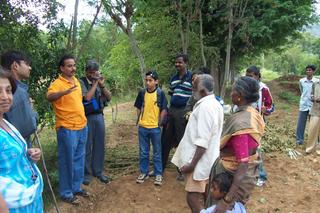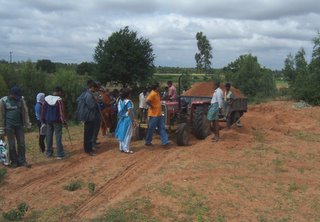A tale of two rivers
Arkavathi and Kumudvathi are two rivers originating from Nandi and Shivaganga hills, which used to play a vital role in Bangalore’s eco-system. These two merge at Tippa Gondanahalli Reservoir which was the main water source for our city before Cauvery river supply came in. But all this is history today as these two rivers are polluted and fast drying up. So a river revival committee has been formed to bring awareness about this situation.

(Talking to elder villagers to during the trek the path of Arkavathi river from the Nandi Hills)
A dam was constructed on the river in the 1930s to create the Thippagondanahalli reservoir which was one of the main sources of drinking water for Bangalore (along with the Hesaraghatta Lake) till the Cauvery water supply projects were commissioned. Arkavathi originates in the Nandi Hills and joins the Cauvery at the Sangama near Kanakapura.
Rajendra Singh, Oxfam India vice-president, said here that the water crisis in Bangalore was caused and compounded by the mismanagement of water resources and pollution of water by both by industry and agriculture. "The misuse and neglect of the Arkavathi river is one such glaring example,'' he added. Among those assisting Oxfam in the Save Arkavathi campaign are the Citizens Forum (a group of people from villages along the river), Dalit Sangarsha Samithi, Karnataka Rajya Raitha Sangh and Samvadha.
These organisations are concerned about the damage caused to the river and its catchment areas from Nandi Hills to the periphery of Bangalore. They say too many residential layouts, educational institutions, and industries have come up letting pollutants into the river. This is apart from residue of chemical fertilizers and pesticides from farms, which pollute the river.
For the Bangalore Water Supply and Sewerage Board (BWSSB), the "dead storage" at T.G. Halli is a matter of concern. At its optimum level, the reservoir has the potential to augment the city's water supply by 149 million litres a day (MLD). While the recent spell of rains has increased inflows, the storage level has to go up considerably and cross the 7.6-m mark before water can be pumped out from the reservoir. If the storage level improves to that extent, 1 MLD can be pumped to the city, BWSSB authorities say. http://www.bwssb.org/water_source_schemes.html
The last time the T.G. Halli reservoir had surplus water was in 1988. The BWSSB is now on a greening spree along the catchment area of the Arkavathi with the help of NGOs. According to Oxfam, which held a Jala Chetana Yatra acrosss the country, for every instance of water pollution and mismanagement, there is an example of conservation and regeneration. A serious effort at rainwater harvesting through rooftop storage has been successful in Doddaballapur, 40 km from the city. http://www.hindu.com/2004/05/31/stories/2004053111800300.htm
NGO organises march to protect Arkavathi
A group of some 200 people braved a scorching Sunday sun to embark on a "padayatra" to save the Arkavathi River — one of the two streams feeding the Tippagondanahalli (T.G. Halli) Reservoir, till recently an important water source for Bangalore.
(Talking to contractors who are illegally-transporting sand on the dried Arkavathi river bed)
The group trekked six-and-a-half km. from the mouth of the river to a village called Alur. The organiser, Navachetana Trust, had planned a walk up to Makali village. "We took too much time getting to Alur," Patrick, a field worker for the trust, said.
The group comprised 20 members from the Rotaract Club of Bangalore West, 50 scouts from Malleswaram, villagers living in and around the T.G. Halli catchment area, and members of other city-based non-governmental organisations (NGOs). The walk led them through Tarabanahalli and Huralichikkanahalli. "We told the villagers the importance of protecting the path of the Arkavathi," Mr. Patrick said.
At a place called T.B. Cross, A.N. Yellappa Reddy, an environmentalist and a former Environment Secretary, spoke to the scouts and the Rotaract Club members about the importance of conserving trees and their role in determining the climate. Members of the Aniketan group that specialises in "kranti songs" and street plays performed at Alur and Tarabanahalli.
A minor commotion occurred at Tarabanahalli because the villagers initially thought the group consisted of Government officials. Mr. Patrick said the villagers thought that the group "had gone there to ask for money". Things were cleared up eventually. After a brief stopover for lunch, the group returned to Bangalore by 4 p.m.
Trust members said they planned to organise more such walks. They said the group met fortnightly at Yavanika on Nrupathunga Road. "And every 10 days, we take a group from the city (usually from different parts of the city) to help clean up the Hessarghatta Lake near T.G. Halli," the trust members said.The trust had taken up an afforestation programme called "Project Vananjali" to restore the forest cover around the T.G. Halli Reservoir (also known as Chamaraja Sagar) and through the "padayathra" wanted to create awareness about encroachment in the T.G. Halli catchment area. "We welcome sponsorship for these programmes," the members said. To contact the trust on 10th floor, Tower Block, Unity Buildings, J.C.Road, call 22126855 or email: plus@satyam.net.in.
The Hindu. Friday, Nov 15, 2004
http://www.hindu.com/2004/05/11/stories/2004051106520300.htm


1 Comments:
:) that was an extensive detail of Tippagondanahalli. I had a different view of the same place.
Here is a link to my review
http://sanjaykattimani.blogspot.com/2004/08/short-hand-form-of-communication.html
Post a Comment
<< Home